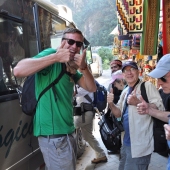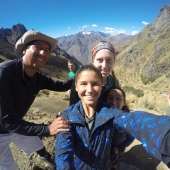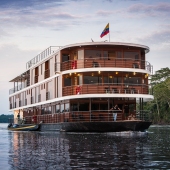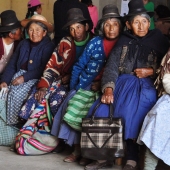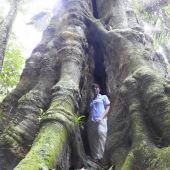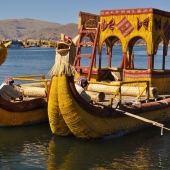
Peru Plans First Ever Direct Road to Machu Picchu
The Peru Ministry of Transport and Communications is actively building a 22 mile road from the village of Santa Maria to Hidroelectric station in the high jungle region right behind Machu Picchu. Hallelujah! A real paved road! That's the good news. The not so good news, is that the road is not actually going all the way to Machu Picchu. Or even the village of Aguas Calientes. Somehow when everyone heard they were building a road on the backside of Machu Picchu, they assumed it was going to the Machu Picchu gateway town of Aguas Calientes. Currently, the only way to get to Machu Picchu is by train or by hiking the Inca Trail. It's a cumbersome journey from Cusco that takes about 5 hours each way. So the mere mention of a direct route by road is a pretty big deal. Even a game changer.
But before you break out the chicha beer, be aware that this is not the first administration to announce plans to build a road directly to Machu Picchu. Members of Garcia's administration also planned to build a road sometime during the 2006-2011 term. Obviously that never happened. And it turns out that the road currently under construction will marginally improve the journey for tourists going to Machu Picchu. However, the local communities who live back there are thrilled. They're isolated from the modern world, (which isn't necessarily a bad thing from my point of view. But then I don't have to live there. So. There's that.)
Some of you may have heard of the backdoor "jungle route" to Machu Picchu. I have been there a few times, most recently in April 2024. (that's when I missed getting smashed by a mudslide, by minutes. Not kidding. Here's the link to read THAT story.) The high jungle behind Machu Picchu is an incredible place.if you're up for 7 hours of driving from Cusco through the Sacred Valley, up over the 15,000 ft Abra Malaga pass to descend into the semi-tropical valley that lies behind Machu Picchu. Extensive construction is actively underway and traffic is only allowed to pass for short periods of time, so getting there is not exactly fun.
There are two small villages called Santa Maria and Santa Teresa that offer a little bit of infrastructure for people who want to spend a couple of days to enjoy river rafting, ziplining and a dip in the hot springs. Not to mention great hiking through small coffee plantations and fruit tree farms.
Not far from Santa Teresa is the Hidroelectric station which offers limited service and a 35 minute train ride to the village of Aguas Calientes. Train service is so limited and unreliable that most people end up walking next to the river for a couple of hours. That's what I did. It's pretty easy walking to Aguas Calientes, but you have to carry all your stuff. From Aguas Calientes, people can take the shuttle buses up to Machu Picchu or stay overnight in relative comfort in various hotels in the pedestrian-friendly town. After your visit to Machu Picchu you can take the train back to Ollantaytambo or Cusco. Travel time is 4-5 hours.
The Plan for the Road Behind Machu Picchu
The goal is to end up with a 2 lane paved road from Cusco all the way to the hidtroelectric station. Most of the distance is already paved, but I've seen sections of road over there get washed out. Building even a short 22 mile segment in rugged mountains is a huge undertaking. After riding all over Peru in buses and cars, including the road to Bolivia, Colca Canyon and even up north in Chachapoyas, I have some observations about roads in Peru. They just can't seem to nail down that whole smooth, speedy pavement thing. To be honest their track record for good roads is downright iffy.
For instance, in Cusco, they have a 4-lane "freeway" to the South Valley region that has huge speed bumps on it. Apparently the road dissected a neighborhood and the local people were occasionally killed by cars when they dashed across the freeway because the footbridges built over the roads weren't placed where needed.
Another example is the new road built through Pachar. It was meant as an alternative route to reduce the drive time between Cusco and Ollantaytambo where the main train station is located. The current route through Chinchero and Urubamba takes over 1 hour.45 minutes each way if you have "clear sailing," which is rare. The 2-lane roads get bogged down by trucks and cars not to mention bottlenecks through small towns. So the Pachar route offers an alternative that could ideally knock 20 minutes off the drive. But the road is haunted by constant rock slides and is often closed to through traffic. After being open 2 years, and one of those years being 2020, the road is already trashed with piles of rocks that block one lane which forces 2 way traffic to share single lanes, also strewn with chunks of scattered rocks. Hardly the speedy highway that everyone envisioned.
Having an actual road all the way to Machu Picchu is apparently not happening. So just stop dreaming about skipping the trains and driving yourselves through the Andes Mountains. This is not the smooth Blue Ridge Parkway that winds gently through the Appalachian Mountains. Having a road would enhance the lives of local residents in Aguas Calientes who have no access to the outside world except by the train. Not to mention benefits to citizens of the small communities behind Machu Picchu, who deal with limited infrastructure including dirt roads, funky cell phone service, and limited access to things like banking and medical services.
There is literally no alternative way to get to Machu Picchu even in the most dire emergency. One year they had to arrange helicopters to rescue tourists stranded in Aguas Calientes when a mudslide took out the train tracks on the main route to the village of Ollantaytambo. It took 4 days! And I remember another time when the train was out of commission and one of our groups was fit enough to do the 3 hour hike in reverse to Hidroelectric where one of our drivers was waiting to take them 7 hours to Cusco. Having a means to haul in construction supplies by truck to the village of Aguas Calientes would help business owners make improvements to their properties in the isolated village. So. Supplies will continue to be delivered by train, then transported through the streets on the backs of local men. And the village will remain the charming little getaway where 1 night is plenty of time to see it all.
When will the new road to Machu Picchu Hidroelectric station be done?
Completion of the 22 mile road is expected sometime in 2025. Give or take 12 months. The new road is expected to trim the 7 hour ride from Cusco down to 4 hours. Each way if that's what you want. But remember. The final leg of that 5 hour journey will be an additional 35 minutes by train on the hidroelectric route. This little segment of railroad tracks is in an area that is prone to landslides. That's where I was hiking in April 2024 when the 2nd mudslide of the season hit and took out the bridge I was trying to hike over. That story can be viewed by clicking here.
And speaking of roads to Machu Picchu, what about the new airport project in Chinchero. It's on its way!
Can you drive to Machu Picchu?
Just in case you're imagining yourself renting a car and driving to the ancient Inca citadel with your hair blowing in the jungel breeze, I would let go of that one. (link to more info about why you can't drive to Machu Picchu)


